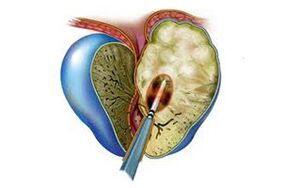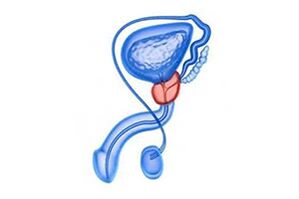Acute prostatitis is an acute inflammation of the prostate gland caused by an infection.With the disease, swelling of the prostate develops, and purulent foci appear in its tissues.Statistical data give us the right to say that acute prostatitis in men is a common disease;the risk of its occurrence increases with age.
The effectiveness of the treatment of acute prostatitis directly depends on the timeliness of the patient's treatment.The disease quickly turns into a chronic form, the treatment of which is longer and more complex.
Forms of acute prostatitis
If we talk about the clinical development of acute prostatitis in men, the disease has three forms (stages):
- catarrhal;
- follicular;
- parenchymal.

The first occurrence is catarrhal inflammation, characterized by the expansion of acini and the appearance of reactive edema of the interstitial tissue.This leads to a significant enlargement of the prostate.The next stage is the rapid spread of inflammatory processes in the lobes and excretory ducts of the prostate.In particular, we are talking about the excretory ducts of the prostate glands, which lead to the back of the urethra.Inflammatory changes affect only the mucous membranes.The excretory ducts lose their contraction, become significantly narrowed or completely blocked, thus preventing the release of prostatic secretions.The catarrhal form is directly related to the infectious pathogen that has migrated from the back of the urethra.Since the inflammatory process also affects the secretion of the prostate, it can trigger the appearance of posterior urethritis.
In the follicular stage, the foci of inflammation reach and spread in individual lobes or in the entire prostate gland.Purulent foci appear, pus passes into the urethra.Prostate enlargement does not stop;tissues undergo destructive changes.
In the parenchymal stage of acute prostatitis, inflammatory processes affect the interstitial tissue of the prostate.This stage occurs after contact or hematogenous penetration of an infectious agent, for example after surgery.
Parenchymal prostatitis is associated with the appearance of single pustules at the beginning of the disease, which merge and combine with a prostatic abscess during the development process.
As for the follicular and parenchymal forms, during their development, inflammatory changes often occur in the back of the urethra and the neck of the bladder.
Prediction and prevention of acute prostatitis
In the vast majority of cases, timely etiotropic therapy can eliminate the symptoms of acute prostatitis.If treatment is not carried out, it is possible that an abscess will develop or the disease will become chronic.
The prevention of this disease usually means the timely treatment of infectious diseases in the body, as well as the identification and treatment of sexually transmitted diseases and urethritis.The man must lead a healthy lifestyle, especially with regard to increasing physical activity.In addition, the development of the disease is prevented by a regular sex life and the absence of unprotected casual relationships.Strict adherence to personal hygiene rules is another important requirement for a man at any age.
Causes of the disease
Acute prostatitis in men can occur at any age.The reason for this is often the penetration of various infectious pathogens.This is E. coli, but streptococci, staphylococci, Candida fungi, chlamydia, trichomonas can also occur.The most common way to get in is through the selection channels.The pathogen can also enter the prostate gland from the bladder, which is undergoing an inflammatory process (for example, acute cystitis).The infection can also spread from purulent foci located in the immediate vicinity.
The inflammatory process caused by the presence of microorganisms in the prostate can occur for various reasons.Factors that increase the risk include:
- surgical interventions in the area of the urethra;
- unprotected sex, inflammatory diseases of the urogenital tract in a partner;
- use of a urethral catheter;
- prostate stones etc.
The occurrence of acute prostatitis cannot be associated with infections.It can occur as a result of a sedentary lifestyle, hypothermia, and various disorders that lead to stagnation in the pelvic area.
Symptoms of acute prostatitis
Since acute prostatitis has different stages, the symptoms of the disease often depend on them.But there are common features that unite all forms.First of all, this is pain, general intoxication, as well as problems with the urination process.
The catarrhal form is usually accompanied by severe pain, heaviness in the perineal area, frequent urination, and painful sensations.During palpation, the doctor may notice an increase in the size of the prostate.The results of the secretion tests may show a high level of white blood cells.

The symptoms of acute prostatitis are more pronounced in the follicular form.A man feels pain in the perineum that radiates to the sacrum or penis.The process of urinating is accompanied by pain, urine remains behind, and there are often difficulties with defecation.General malaise and the patient has a fever.An enlarged prostate can be seen on palpation, and its contours become asymmetrical.Focal pain may occur.Tests show an increase in the level of leukocytes and the presence of purulent fibers in the urine.
The parenchymal form is accompanied by a sharp increase in body temperature, the values can reach 39.5 degrees.General symptoms are pronounced: chills, loss of appetite and weakness.Urination is delayed, the process is accompanied by severe pain.Passing stool is also difficult, constipation becomes severe.
In such cases, acute prostatitis treatment should be started urgently.If the process starts, there is a high probability of prostate abscess, paraprostatitis, paraprostatic venous plexus phlebitis.If the patient does not consult a doctor, the disease becomes chronic and the probability of complete recovery decreases significantly.
Diagnosis of acute prostatitis
When the patient contacts a urologist, the doctor diagnoses acute prostatitis and determines the stage of the disease.The specialist receives the information after conducting a comprehensive examination.The diagnostic methods used in this case consist of physical, instrumental and laboratory tests.
The physical examination consists of studying the state of the prostate from the rectum.In this way, the specialist gets the opportunity to assess the size, shape, consistency, and presence of pain.As a result of the analysis of the secreted secretion, it is easy to determine the decrease in the number of lecithin particles and the increase in the level of leukocytes.
Palpation of the gland involves the collection and transfer of urine for examination.In most cases, acute prostatitis is indicated by an increase in the level of leukocytes.Urine culture, PCR and blood culture, as well as analysis of urethral discharge are also prescribed.
Instrumental methods in this disease are represented by transrectal ultrasound diagnostics.If the patient has severe pain, the examination is chosen by the transabdominal method.
When the question of surgical intervention arises, it becomes necessary to perform CT and MRI of the pelvis.
Treatment of acute prostatitis
Acute prostatitis is treated in a hospital environment.This is due to two factors.First, there is the risk of serious complications that can affect men's health and subsequently affect reproductive function and erection quality.Secondly, the disease is complex, accompanied by pronounced symptoms and painful sensations.Treatment of acute prostatitis begins with drug therapy, etiotropic drugs are prescribed to the patient.The most important role is played by antibacterial agents, which suppress the activity of microorganisms.
In order to reduce the severity of the pain and get rid of the spasms, the patient is recommended to take antispasmodics and painkillers.Sometimes thermal enemas and rectal suppositories are used to relieve the condition.After overcoming the acute symptoms, it is possible to use physiotherapy.These procedures increase microcirculation, improve local immunity and help eliminate inflammation.The most effective physiotherapy methods for the treatment of acute prostatitis are prostate massage, microwave therapy and electrophoresis.For many years, prostate massage has been a particularly popular measure to help relieve congestion;It is also recommended for men over the age of forty to use it regularly as a preventive measure.
A catheter is not used in case of problems related to the urination process;instead, trocar cystostomy is preferred.
Recovery is the regeneration of the prostate tissue and the complete restoration of its functions, while laboratory tests show that infectious pathogens are absent, and the secretion of the prostate returns to its normal composition.
Surgery is not widely used to treat prostatitis.It doesn't always bring results.The surgical solution brings positive dynamics in less than half of the cases.The most common side effect of the operation is erectile dysfunction, retrograde ejaculation is also common, during which the sperms enter the bladder during ejaculation, and sometimes the narrowing of the ureter also occurs.The surgical method does not guarantee relapse.Therefore, surgical intervention is used only in certain cases, for example:
- the occurrence of a prostate abscess, which must be opened and cleaned;
- the lack of results of treatment with conservative methods in the form of drugs, traditional medicine, physiotherapy procedures;
- development of serious complications;
- the presence of an inflammatory focus in the pelvic area;
- development of paraproctitis (purulent abscess in cells located around the rectum);
- the presence of blood in the urine;
- delayed urination and cessation of urination (anuria);
- the presence of stones in the bladder, kidneys, the cause of which was prostatitis;
- suspected malignancy.































